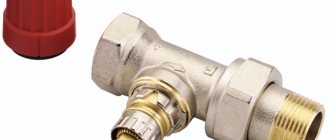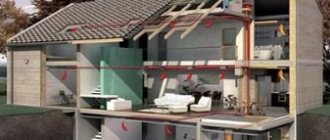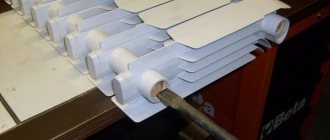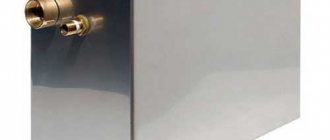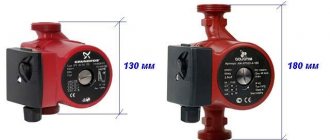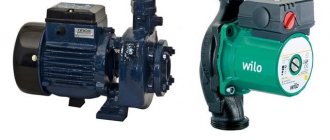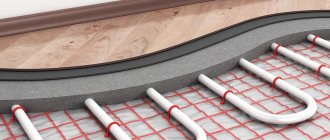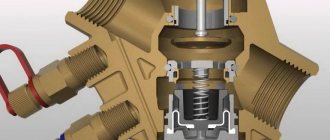One of the most necessary devices in any private or multi-storey house is heating radiators. They warm up rooms during the cold season, creating a comfortable microclimate in each room. When replacing a battery, it is necessary to determine not only its type, installation method and connection to pipes, but also the installation of additional technical elements. Such elements include valves, valves and specialized taps for heating radiators.
Which taps for heating radiators to choose
Ball valve
This is the most famous type of shut-off valve. Inside it there is a smooth ball that has a through hole and is capable of rotating 90°C, thus regulating the flow of water in the pipe, closing or opening it. The design of the mechanism provides it with minimal resistance to flow when open. It is designed to operate in the fully open or fully closed position to quickly shut off the water or, in some cases, drain it. Intermediate provisions are possible, but prohibited.
The materials for these mechanisms will be nickel-plated brass and stainless steel; for metal-plastic systems, polymer materials are also used. There are expensive and high-quality cranes from the Danfoss, Giacomini, and Bugatti brands on the market. For limited financial capabilities, Chinese and Turkish Valtec and Fado are offered. Good quality at a low price is offered by the Chinese AGUA-WORID.
The most common type of tap is a valve. Allows you to regulate the pressure. The flow channel inside it is perpendicular to the flow of liquid in the supply pipes. Installation must be carried out with careful attention to the markings so that water flows only in one direction.
For heating systems there are valves with a conical valve. They are most effective for such conditions. Fully open, it allows the maximum amount of liquid to pass through, which makes the thermal output of the battery more efficient. The mechanism allows you to reduce the flow of coolant and reduce heat transfer if the room is too hot and, thus, control the temperature.
There are these types:
- adjusting (straight and angular). They have manual control. Used in autonomous heating. They cannot accurately adjust heat transfer due to the lack of a scale and temperature sensor;
- equipped with a thermal head. Their design allows the temperature rise to be blocked or limited through manual or automatic control. Installed on two- and one-pipe systems. Adjustment is simple - the required temperature is set manually using a limit ring;
- with thermostat. Installed in front of the battery. The flow of coolant is controlled by a tap mounted in front of the thermostat.
There are no valve taps made of plastic; they are made from brass, steel or a combination of these materials.
Selection and installation of radiator taps
Connecting heating devices using properly selected shut-off and control valves improves the functionality of the heating system and makes operation more convenient. The tap for the heating radiator must be made of high-quality materials and installed correctly.
Fittings for heating radiators are divided into shut-off (blocks the coolant flow) and regulating (designed to control the flow intensity). Taps are only shut-off valves; regulating valves are valves and valves. But in everyday life, taps mean all types of shut-off and control valves.
Ball valve
This is the most famous type of shut-off valve. Inside it there is a smooth ball that has a through hole and is capable of rotating 90°C, thus regulating the flow of water in the pipe, closing or opening it. The design of the mechanism provides it with minimal resistance to flow when open. It is designed to operate in the fully open or fully closed position to quickly shut off the water or, in some cases, drain it. Intermediate provisions are possible, but prohibited.
The materials for these mechanisms will be nickel-plated brass and stainless steel; for metal-plastic systems, polymer materials are also used. There are expensive and high-quality cranes from the Danfoss, Giacomini, and Bugatti brands on the market. For limited financial capabilities, Chinese and Turkish Valtec and Fado are offered. Good quality at a low price is offered by the Chinese AGUA-WORID.
The most common type of tap is a valve. Allows you to regulate the pressure. The flow channel inside it is perpendicular to the flow of liquid in the supply pipes. Installation must be carried out with careful attention to the markings so that water flows only in one direction.
For heating systems there are valves with a conical valve. They are most effective for such conditions. Fully open, it allows the maximum amount of liquid to pass through, which makes the thermal output of the battery more efficient. The mechanism allows you to reduce the flow of coolant and reduce heat transfer if the room is too hot and, thus, control the temperature.
There are these types:
- adjusting (straight and angular). They have manual control. Used in autonomous heating. They cannot accurately adjust heat transfer due to the lack of a scale and temperature sensor;
- equipped with a thermal head. Their design allows the temperature rise to be blocked or limited through manual or automatic control. Installed on two- and one-pipe systems. Adjustment is simple - the required temperature is set manually using a limit ring;
- with thermostat. Installed in front of the battery. The flow of coolant is controlled by a tap mounted in front of the thermostat.
There are no valve taps made of plastic; they are made from brass, steel or a combination of these materials.
Types of heating systems and the principle of adjusting radiators
Handle with valve
In order to correctly adjust the temperature of radiators, you need to know the general structure of the heating system and the layout of the coolant pipes.
In the case of individual heating, adjustment is easier when:
- The system is powered by a powerful boiler.
- Each battery is equipped with a three-way valve.
- Forced pumping of coolant has been installed.
At the stage of installation of individual heating, it is necessary to take into account the minimum number of bends in the system. This is necessary in order to reduce heat loss and not reduce the pressure of the coolant supplied to the radiators.
For uniform heating and rational use of heat, a valve is mounted on each battery. With it, you can reduce the water supply or disconnect it from the general heating system in an unused room.
- In the central heating system of multi-storey buildings, equipped with a vertical supply of coolant through a pipeline from top to bottom, it is impossible to adjust the radiators. In this situation, the upper floors open the windows due to the heat, and the rooms on the lower floors are cold, since the radiators there are barely warm.
- A more advanced one-pipe network. Here, the coolant is supplied to each battery and then returned to the central riser. Therefore, there is no noticeable temperature difference in the apartments on the upper and lower floors of these buildings. In this case, the supply pipe of each radiator is equipped with a control valve.
- A two-pipe system, where two risers are mounted, ensures the supply of coolant to the heating radiator and back. To increase or decrease the coolant flow, each battery is equipped with a separate valve with a manual or automatic thermostat.
Thermal head
The next type of radiator tap is a thermal head for a heating radiator.
If there is a need to provide automatic temperature control, then using thermal heads together with a thermostatic valve will come in handy. This type allows you to adjust the optimal temperature without any human intervention.
Features of the functioning of the thermal head?
The thermal head functions inversely depending on the air temperature in the room. If the temperature increases (much higher than the comfortable and optimal temperature - this phenomenon can be observed when there are a large number of people in the room, or the operation of many electrical appliances), then the bellows of the thermal head expands. The expansion of the bellows of the thermal head leads to the fact that a certain part of the valve (stem) begins to move and there is a decrease in the flow of the heat generator through the radiator. If the air temperature, on the contrary, decreases, then this mechanism works in the opposite direction in order to increase the temperature for a comfortable and optimal temperature for the room.
Typical dimensions of thermal head valves
Basically, the typical and most common head size is M30*1.5. But the sizes are individual for each model. Today, manufacturers in most cases mark cranes, indicating their exact dimensions and production characteristics. The markings indicate special symbols with which the indicators are deciphered.
Installation of thermal heads
- Using certain rods, the plate is attached to the wall.
- The thermal head is fixed on the plate itself.
- Next, fixation is performed on the wall of the capillary tube.
- The thermal head is installed according to certain marks.
- Tighten and fix the bolt.
Features and differences between corner taps and straight taps, their advantages
What are the positive characteristics of corner taps?
- There is a guaranteed ability to turn off the battery.
- Resume operation of the heating system at any convenient time, if necessary.
- Guaranteed ability to independently adjust the temperature, which will be comfortable and optimal for being in the room (if there are temperature changes outside, and so on).
- The angle tap is very convenient to use, especially when draining a heat generator. This greatly reduces the time for this procedure.
- Easy maintenance.
When choosing between corner and straight taps, it is recommended to mainly use corner taps due to the above-mentioned positive features.
Types of materials used
When deciding which faucet to install on the heating radiator, you should pay attention to the material it is made of. First of all, the main requirement for the material is its anti-corrosion properties.
Most often, synthetic brass is used for production, and products made from high-quality polypropylene are also popular. The top layer can be additionally protected by metal spraying.
Depending on the material, the types of fastenings differ. Thus, a brass faucet is attached using a fitting or thread to pipes made of plastic or metal. To install a polypropylene valve, you will need to select a welding method.
Network connection
To independently connect to propylene pipes, you need to have a special soldering iron.
There are two connection options:
1. If the radiator valve is made of propylene, then its plastic pipe is connected by soldering directly to the connection. Then the American metal end is unscrewed from the tap and screwed into the radiator liner, using flax winding with paste or FUM tape to seal the connection. After which the “American” is reassembled and the union nut is tightened with a wrench.
2. If the radiator valve is metal, then to connect to the plastic liner use a combined detachable coupling with an internal thread. This coupling is similar in connection principle to the metal “American” one, but the union nut is located on a plastic solder end. The plastic part of the coupling is soldered to the supply pipe through a connecting fitting. The coupling is disassembled, the mating metal part is screwed onto the valve body and then assembled again, tightening the union nut with a wrench.
1 - “American”; 2 - ball valve; 3 - combined detachable coupling; 4 - polypropylene coupling; 5 - polypropylene liner
When connecting to a metal supply, you must also first connect the ball valve or thermostat to the pipe. It is not necessary to have welding skills - connecting the shut-off valves to the pipe can be done using a threaded connection. To do this, it is necessary to cut a thread on the cut part of the eyeliner. They do this using a clamp. A set of sockets and a mandrel with one or two handles is quite expensive, but you can buy only one socket head of a specific size, and use a regular gas wrench as a mandrel with a handle. The sequence of work will look like this:
- the supply pipes are cut with a grinder to the required size, trying to ensure that the cutting plane is perpendicular to the axis of the pipe;
- clean the end of the pipe from rust and use a file to make a small chamfer;
- Lubricant is applied to the working section of the pipe and the clamping cutters;
- place the head on the chamfer;
- center it relative to the axis of the pipe;
- Holding the head with your hand, using a gas wrench, begin to turn it clockwise.
Useful information for those who want to choose a universal locking device
Valve on the battery
Choosing a tap for a radiator
It is important to pay attention to the material from which it is made. The locking device operates in the most aggressive environment. It is constantly in water, exposed to high temperatures and hydraulic shocks.
Therefore, it is important that the material can withstand all these negative factors
It is constantly in water, exposed to high temperatures and hydraulic shocks.
Therefore, it is important that the material can withstand all these negative factors
Most often, radiator taps are made of alloys. Most models are made of brass. This is a very durable metal that is not afraid of corrosion. But for even greater strength, the brass is coated on top with a protective metallic compound. This is the best option for use in a heating system.
Sometimes, instead of brass taps, sellers can slip in counterfeits - silumin control valves, which look exactly like the original models.
After a year of operation, breakdowns often occur that can lead to utility accidents. After all, silumin rusts very quickly from the inside, and corrosion instantly corrodes the body, making its walls very thin. Therefore, any water hammer easily breaks the locking device. Even if this does not happen, there are often cases when, when simply opening or closing a tap, it simply remains in the hands of a person, falling off from the base. If there is hot water inside the battery at this time, burns will definitely occur. So beware of fakes!
So, the tap for the heating battery must be made of brass - only this alloy can easily withstand high temperatures and water shocks. It is better to choose ball locking mechanisms that have long warranty periods and demonstrate increased tightness. This crane can be installed in both horizontal and vertical positions.
Functional purpose
Why complete the radiator with taps? Their installation when connecting heating devices makes it possible
:
- completely turn off the radiators if for some reason the room is temporarily not required to be heated;
- shut off the coolant supply to flush or inspect individual radiators without draining the coolant from the entire system;
- regulate the intensity of heat transfer from batteries manually or automatically, maintaining a comfortable temperature in the room;
- remove air pockets from radiators, increasing system efficiency and reducing the risk of corrosion of metal elements.
Types of control valves
Existing modern heat supply technologies make it possible to install a special tap on each radiator that controls the quality of heat. This control valve is a shut-off valve heat exchanger, which is connected via pipes to the heating radiator.
According to the principle of their operation, these cranes are:
Ball ones, which primarily serve as 100% protection against emergency situations. These shut-off devices are a structure that can be rotated 90 degrees and can allow water to pass through or prevent the passage of coolant.
The ball valve must not be left in a half-open state, as in this case the sealing ring may be damaged and a leak may occur.
- Standard, where there is no temperature scale. They are represented by traditional budget valves. They do not provide absolute accuracy of adjustment. By partially blocking the access of coolant to the radiator, they change the temperature in the apartment to an indefinite value.
- With a thermal head that allows you to adjust and control the parameters of the heating system. Such thermostats are automatic and mechanical.
Conventional direct-acting thermostat
A direct-acting thermostat is a simple device for controlling the temperature in a heating radiator, which is installed near it. By its design, it is a sealed cylinder into which a siphon is inserted with a special liquid or gas that clearly reacts to changes in the temperature of the coolant.
As it increases, the liquid or gas expands. This leads to increased pressure on the rod in the thermostat valve. It, in turn, moving, blocks the flow of coolant. When the radiator cools, the reverse process occurs.
Thermostat with electronic sensor
This device is no different in operating principle from the previous version, the only difference is in the settings. If in a conventional thermostat they are performed manually, then an electronic sensor does not need this.
Here the temperature is set in advance, and the sensor monitors its maintenance within the specified limits. The electronic thermostatic sensor regulates the control parameters of the air temperature within the range from 6 to 26 degrees.
Technical specifications
Design types include ball, cone thermostatic valves, and Mayevsky valve.
Ball
The basis of the design is a movable spherical shutter - a ball, with a drilled hole for the passage of water. The ball is connected by a rod to a handle , which is driven into rotation. The valve body is made of steel, bronze and brass, as well as polypropylene.
Photo 1. Full bore ball valve with polypropylene body, suitable for pipes made of the same material.
Ball valves are divided into full bore and standard bore. In heating systems, full-bore ones are most widely used. Due to the absence of narrowing of the pipe diameter, they make it possible to make maximum use of the heat transfer of radiators.
A simple algorithm for selecting a ball valve: if the material of the system pipeline is polypropylene, then the optimal solution would be to install a polypropylene device. In other cases, it is necessary to install equipment with a metal casing. It is recommended to purchase products from reputable manufacturers.
Attention! The ball valve can only be opened halfway, but it cannot be operated in this mode - the wear of parts greatly increases.
Conical
In a cone valve, the control valve has the shape of a truncated cone . When the handle is rotated, the cone moves along the thread , smoothly adjusting the cross-section of the lumen. The most widespread are brass and bronze casings; polypropylene models are only gaining popularity.
Photo 2. Sectional view of the cone tap, made of brass and bronze, adjusts the temperature only approximately.
The design of the cone valve significantly reduces the internal diameter of the pipeline; in a system with such additional resistance, the parameters of the coolant must be strictly observed. Additionally, you will need to regularly clean the tap , often by removing it from the pipeline.
The cone tap will only help you adjust the room temperature approximately.
Cone valves are selected in the same way as ball valves: according to the pipeline material. The reliability of metal fittings is higher than plastic ones, but the latter is somewhat cheaper.
Mayevsky crane
This air release equipment is a metal needle-type shut-off valve. The valve stem is moved by rotating a square screw using a screwdriver or a special wrench. The water that comes with the air must be collected in a container.
Photo 3. The Mayevsky tap on the heating radiator is turned by turning the screw with a screwdriver or a special wrench.
If the radiator is not equipped with a Mayevsky tap at the factory, then when purchasing, pay attention to the connecting size - it must match the size of the pipeline.
Important! The capacity of the tap is very small; do not use it to remove large volumes of air, for example, from a hydraulic accumulator.
Thermostatic
The most complex design is a pipeline valve with a thermostatic head. The pressure rod is controlled by a special container (bellows) filled with liquid or gas. Using the properties of changes in the volume of media with increasing temperature, the bellows, acting on the working cone, regulates the fluid flow.
The initial position of the bellows is set by the user using a digital controller or by rotating a mechanical handle. In complex automatic control systems, the position of the rod is set by a specialized computer , which processes information from external sensors and controls the electric drive.
Photo 4. Thermostatic radiator valve with a special bellows filled with gas or liquid.
To navigate the fittings for domestic use, just pay attention to the markings:
- products with the letter G are used in single-pipe systems;
- with the letter N - in two-pipe;
- The direction of water flow in the operating position is marked by an arrow on the valve body.
Reference! To reduce the influence of the radiator on the thermostat head, it is located at an angle of 90 degrees to the plane of the battery.
Risers and valve that cuts off heating areas
The recommendations of specialists in this case do not differ in the originality of the solution, since plug valves are considered the best choice. It is necessary to create conditions in the risers for discharging the coolant liquid and plugs are chosen for this purpose, but they are not always convenient, since it will be quite problematic to unscrew the plug on the supply riser, through which a water flow with a water temperature of about 90 degrees circulates.
As a result, the conclusion is obvious: valves should be installed to discharge the water.
In this situation, you can use screw devices, since they will not have significant disadvantages:
- if the oil seal is installed correctly, it will not have contact with the water flow under pressure;
- water hammers become impossible, since the valve is mostly closed;
- To replace the gaskets, you do not need to reset the entire house system - it will be enough to stop the riser.
Elevator unit
In apartment buildings at the entrance and exit from the elevator unit of the heating system. As a rule, valves are installed. Their body has two rings made of corrosion-resistant steel, which encircle the passage for the coolant (mirrors). Another pair of mirrors is located on the surface of the valve - its moving part.
When the damper is in the lower position and lowers, it blocks the movement of water, but if it moves to the upper position, it goes beyond the circulating flow. To close the valve, the consumer needs to rotate the handwheel, which drives the screw-threaded rod. A seal packed around the stem will help ensure tightness. For heating and hot water, the product must be graphite. There is no alternative to this device for pipe diameters of 50 millimeters or more. It is necessary to determine which taps are best for heating radiators.
If this parameter is lower, it is recommended to use modern plug valves, such as in the photo, since valves have serious disadvantages:
- it is necessary to periodically fill the oil seal, even when the valve is not in use, since the packing, in contact with water, is gradually destroyed;
- After a short period of time, the cheeks begin to become overgrown with deposits. If the valve sits for several years without being used, it will not be possible to close it completely;
- In the event of an emergency, every second can be decisive. If it takes literally a moment to close the plug valve, then it will take a long time to rotate the valve’s steering wheel, even when it is fully operational.
It should be noted that plug valves, which are a ball with a channel for water surrounded by a plastic shell, differ in:
- practicality;
- durability;
- reliable fluid retention;
- no need for maintenance.
Plumbing specialists do not recommend purchasing and installing a screw valve on a heating radiator or the same products of any other type.
They have significant design disadvantages:
- The seal will need to be filled periodically if there is no desire to put up with constant leakage along the rod. When it is difficult to replace the valve or fill the oil seal, then to eliminate the leak, the valve must be opened all the way with a little force. The leak will stop due to the fact that the thread on the rod will press the oil seal:
- Rubber gaskets for elements of heating structures have a limited shelf life. Heating radiator valves with flat brass valves do not hold water after a certain time due to the appearance of deposits on the valve and seat. The same locking elements with wedge-shaped valves made of brass, after closing them with force, often jam in the seat;
- All screw valves are installed only along the flow of water. For orientation, there is an arrow on the body of many products. Installing a valve against water inflow will certainly end with the valve tearing off and then shutting off the water tightly.
Another undesirable prospect is associated with the operation of the valve - the possibility of water hammer if the valve is not completely closed and turbulence occurs in the water flow, periodically blocking the seat. Water hammer
- These are short-term pressure surges, as a result of which the weakest parts of the heating circuit are destroyed.
How to install correctly
They install a thermostat for a heating radiator at the inlet or outlet of the heating device - there is no difference, they work with equal success in both positions. How to choose a place to install?
According to the recommended installation height. There is such a clause in the technical specifications. Each device is configured at the factory - they are calibrated to control the temperature at a certain height and usually this is the upper radiator manifold. In this case, the heat regulator is installed at a height of 60-80 cm; it is convenient to adjust it manually if necessary.
Installation diagrams for heat regulators for radiators
If you have a bottom saddle connection (pipes fit only from the bottom), there are three options - look for a device that can be installed at the bottom, install a model with a remote sensor, or reconfigure the thermal head. The procedure is simple; the description must be in the passport. All you need is to have a thermometer and at certain moments turn the head in one direction, then in the other direction.
Installation is standard - on fum tape or linen winding with packaging paste
The installation process itself is standard. The valve has a thread. The appropriate fittings are selected for it or a matching thread is cut on the metal pipe.
One important point that those who want to install a thermostat for a heating radiator in apartment buildings should remember. If you have a single-pipe installation, they can only be installed if there is a bypass - a section of pipe that stands in front of the battery and connects the two pipes to each other.
If you have a similar wiring (there may not be a pipe on the right), a bypass is required. The thermostat should be installed immediately behind the radiator
Otherwise, you will regulate the entire riser, which your neighbors will definitely not like. For such a violation, a very substantial fine can be issued. Therefore, it is better to install a bypass (if not).
Useful tips for choosing
Several features are described below in order to decide which products are best to use.
Locking mechanism
Thermostats have two types of locking mechanisms: a valve and a valve with a cone (rod). The latter is preferred, it allows for smooth adjustment. The temperature is set manually using a mechanical limiting ring. There are also electronic mechanisms, they are more autonomous.
It is better to install ball valves than gate valves, which have a number of disadvantages: the seal wears out faster, becomes overgrown with deposits, and takes a long time to close. Disadvantages of the Mayevsky crane: low maneuverability, it requires a special key or screwdriver, which is inconvenient to use. If its rod is accidentally unscrewed, it is very difficult to screw it back, overcoming the water pressure. Instead, it is recommended to install a regular valve or special automatic radiator air vents. The optimal and affordable option if temperature control is required is a faucet with a thermal head.
Housing and connections
It is better to install not standard ball valves on batteries, but full bore ones. In residential buildings and apartments, such mechanisms with a coupling connection are used.
It is better to choose taps for heating radiators with a steel or bronze body, but most often they use brass ones, since they are cheaper. An imitation of brass is silumin. You should not buy a product made from it; it is a very soft metal. Polymer ones are no less reliable, but they have large dimensions. To replace them, you need to cut out a piece of pipe.
Products with polymer rather than rubber gaskets are more durable. The taps for adjusting the coolant on heating radiators make it impossible to change them without draining the water; this can be done with straight-through taps or with an American valve installed (towards the battery).
Products from Itap (Italy) and Danfoss are considered to be of the highest quality. Approximate price range 700–2000 rub. In the middle price range there are Oventrop brand products - 550–950 rubles. For a limited budget, Luxor is suitable - 450–800 rubles. Chinese or Turkish brands.
Types of locking elements - straight and angular
Often, communications passing through the apartment greatly spoil the appearance of the room. In order to somehow disguise heating pipes in niches under windows or in grooves in walls, you will need special corner versions of shut-off and control valves. Fortunately, manufacturers now offer a wide range of such products, and you can choose an angle radiator valve to suit your needs.
It will be possible to decide which type of locking elements you will need only after a detailed study of the system configuration and taking into account a number of factors.
An important role in the process of selecting a crane is played by the convenience of its installation. In addition, the purpose of the shut-off and control valves is important, that is, for what purpose they will be installed, as well as the type of heat source.
Useful tips for choosing
Several features are described below in order to decide which products are best to use.
Locking mechanism
Thermostats have two types of locking mechanisms: a valve and a valve with a cone (rod). The latter is preferred, it allows for smooth adjustment. The temperature is set manually using a mechanical limiting ring. There are also electronic mechanisms, they are more autonomous.
It is better to install ball valves than gate valves, which have a number of disadvantages: the seal wears out faster, becomes overgrown with deposits, and takes a long time to close. Disadvantages of the Mayevsky crane: low maneuverability, it requires a special key or screwdriver, which is inconvenient to use. If its rod is accidentally unscrewed, it is very difficult to screw it back, overcoming the water pressure. Instead, it is recommended to install a regular valve or special automatic radiator air vents. The optimal and affordable option if temperature control is required is a faucet with a thermal head.
Housing and connections
It is better to install not standard ball valves on batteries, but full bore ones. In residential buildings and apartments, such mechanisms with a coupling connection are used.
It is better to choose taps for heating radiators with a steel or bronze body, but most often they use brass ones, since they are cheaper. An imitation of brass is silumin. You should not buy a product made from it; it is a very soft metal. Polymer ones are no less reliable, but they have large dimensions. To replace them, you need to cut out a piece of pipe.
Products with polymer rather than rubber gaskets are more durable. The taps for adjusting the coolant on heating radiators make it impossible to change them without draining the water; this can be done with straight-through taps or with an American valve installed (towards the battery).
Products from Itap (Italy) and Danfoss are considered to be of the highest quality. Approximate price range 700–2000 rub. In the middle price range there are Oventrop brand products - 550–950 rubles. For a limited budget, Luxor is suitable - 450–800 rubles. Chinese or Turkish brands.
Installation
In heating systems of residential buildings, where pipes of small diameters are mainly used, taps are installed on radiators using threaded connections. The most convenient type of connection is recognized as colloquially called “American”. The fitting part is equipped with one or two union nuts, each of which covers the connecting shank and can rotate freely around it. The nut is screwed onto the pipe, pressing the tap against it, while the end of the pipe rests against the gasket installed inside the tap. Installation of fittings on an “American” connection is simpler than on a coupling connection, and the valve can be located quite close to the wall.
American crane.
In order to disassemble the connection, it is enough to unscrew the nut on one side. This allows, for example, to dismantle heating radiators for repairs or access to a section of the wall located behind them without disconnecting the entire riser. Replacing faucets on an American model, as well as installation, requires minimal effort. Most “American” ones have a hexagon shape; their installation on batteries is done using a regular wrench. But in some models the nut is equipped with two protrusions, for which a special key is provided. The first option is undoubtedly more convenient, since wrenches are used quite often in the household, and therefore are always at hand.
When installing the valve for the heating radiator for the first time, all threaded connections are assembled without sealing. In this way, they find out whether the parts fit together well and how freely they move. Knowing this, you can determine the amount of sealing material that will be needed for a given threaded connection. A lack of seal will lead to a leak, but its excess is even more undesirable: while tightening, the nut may burst, the only way out in this case is to replace the entire part.
Types of control valves
Existing modern heat supply technologies make it possible to install a special tap on each radiator that controls the quality of heat. This control valve is a shut-off valve heat exchanger, which is connected via pipes to the heating radiator.
According to the principle of their operation, these cranes are:
Ball ones, which primarily serve as 100% protection against emergency situations. These shut-off devices are a structure that can be rotated 90 degrees and can allow water to pass through or prevent the passage of coolant.
The ball valve must not be left in a half-open state, as in this case the sealing ring may be damaged and a leak may occur.
- Standard, where there is no temperature scale. They are represented by traditional budget valves. They do not provide absolute accuracy of adjustment. By partially blocking the access of coolant to the radiator, they change the temperature in the apartment to an indefinite value.
- With a thermal head that allows you to adjust and control the parameters of the heating system. Such thermostats are automatic and mechanical.
Conventional direct-acting thermostat
A direct-acting thermostat is a simple device for controlling the temperature in a heating radiator, which is installed near it. By its design, it is a sealed cylinder into which a siphon is inserted with a special liquid or gas that clearly reacts to changes in the temperature of the coolant.
As it increases, the liquid or gas expands. This leads to increased pressure on the rod in the thermostat valve. It, in turn, moving, blocks the flow of coolant. When the radiator cools, the reverse process occurs.
Thermostat with electronic sensor
This device is no different in operating principle from the previous version, the only difference is in the settings. If in a conventional thermostat they are performed manually, then an electronic sensor does not need this.
Here the temperature is set in advance, and the sensor monitors its maintenance within the specified limits. The electronic thermostatic sensor regulates the control parameters of the air temperature within the range from 6 to 26 degrees.
Purpose. Characteristic
Taps ensure efficient operation of water pipes. The heating system cannot operate without these devices, and in some situations, using it without them becomes downright dangerous.
Functions
When the riser leaks, it is the shut-off valves that shut off the water, which makes it possible to make repairs without stopping the entire system. An important function will also be managing the heat dissipation of the battery.
The minimum set for the normal functioning of a conventional heating system consists of several types of shut-off and control valves. When connecting to the radiator, shut-off ball valves are mounted on the supply pipes, on the outlet and on the bypass. A mechanism is installed on the supply to adjust the coolant pressure. The radiator itself must be equipped with a Mayevsky valve to bleed air. As you can see, the number of such products is significant and this is by no means an excessive option.
Taken together, this system allows:
- turn off the radiator without shutting off the entire circuit for repair, replacement, or maintenance;
- direct all coolant through the heater with the bypass turned off;
- control the pressure power through the radiator to reduce or increase the temperature;
- drain water, bleed air;
- protect the system from hydraulic shocks and breakdowns;
- regulate the efficiency and level of heat supply, which saves heating costs.
Requirements
The criteria for the variety of types of taps placed on heating radiators are: design, principle of operation and material. It is important to know that mechanisms of this type are divided into shut-off and control valves. What are the best taps to install? It must be taken into account that they have a rather complex structure and must meet a number of requirements in order to function in difficult conditions.
Standard Requirements:
- coolant temperature up to 200°C;
- must withstand pressure of 16–40 bar;
- high corrosion resistance;
- resistance to mechanical loads.
For heating systems, such mechanisms are made more stable. Conventional taps and valves for cold water cannot be installed in heating radiators.
Features of installation and maintenance of regulators
Thermostat installation diagram
After choosing the optimal model of thermostat or tap for regulating the heating temperature, you should install them correctly. The location of the fittings directly depends on its function and design.
Most often, the adjustment components are mounted in the trim of a specific heating radiator. They are installed on the supply pipe or on the bypass. In order to comfortably adjust the temperature of the radiators, it is recommended to adhere to the following rules:
- The device should not be covered with decorative panels or other interior items;
- The service life of thermostats largely depends on the quality of the coolant. Therefore, a mesh filter should be installed in front of it, which will protect the valve seat from limescale;
- When installing the heating temperature control valve, you must follow the installation diagram. On the body of the device, arrows indicate the direction of movement of the coolant;
- Many thermostats and servos are connected to the electrical network. Therefore, it is necessary to provide power supply to them.
Before installing and further adjusting heating batteries in an apartment, you must read the manufacturer's instructions. It specifies the installation conditions for the operation of a specific adjusting element.
One of the important indicators of apartment heating control valves is the maximum and minimum throughput. They must match the current system parameters.
Why are shut-off and control devices needed?
More recently, batteries were connected to the rest of the heating system without any additional elements. Today, the installation of almost every radiator automatically involves the installation of taps. The reason for such changes is related to savings and the possibility of unplanned situations.
If the seal of the radiator is broken, it leaks, or becomes clogged, you can simply turn the valve, blocking the access of water, and remove the battery for repair or cleaning.
To do this, you don’t even have to drain the water from the entire system.
Such taps are called shut-off taps. They are installed on pipes through which fluid is supplied and discharged. In open mode, they do not interfere with the free flow of water, but in closed mode, they completely block its supply.
Shut-off valves for radiator
The tap is necessary to remove air accumulated in the heating system. Usually it is called "Maevsky".
Some taps allow you to adjust the heating temperature of the heating system. With their help, you can save on heating by lowering the heating temperature of the radiators or turning them off if it’s warm outside. This is true for both private houses and apartment buildings.

